Page 79 of 498
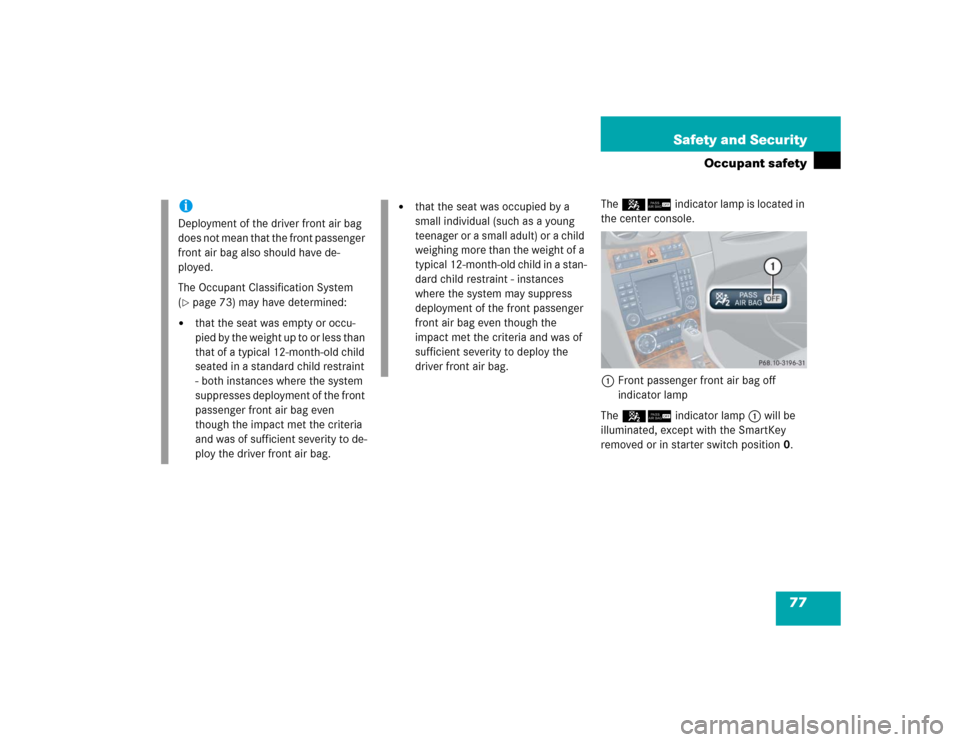
77 Safety and Security
Occupant safety
The 56indicator lamp is located in
the center console.
1Front passenger front air bag off
indicator lamp
The 56indicator lamp1 will be
illuminated, except with the SmartKey
removed or in starter switch position0.
iDeployment of the driver front air bag
does not mean that the front passenger
front air bag also should have de-
ployed.
The Occupant Classification System
(�page 73) may have determined:
�
that the seat was empty or occu-
pied by the weight up to or less than
that of a typical 12-month-old child
seated in a standard child restraint
- both instances where the system
suppresses deployment of the front
passenger front air bag even
though the impact met the criteria
and was of sufficient severity to de-
ploy the driver front air bag.
�
that the seat was occupied by a
small individual (such as a young
teenager or a small adult) or a child
weighing more than the weight of a
typical 12-month-old child in a stan-
dard child restraint - instances
where the system may suppress
deployment of the front passenger
front air bag even though the
impact met the criteria and was of
sufficient severity to deploy the
driver front air bag.
Page 80 of 498
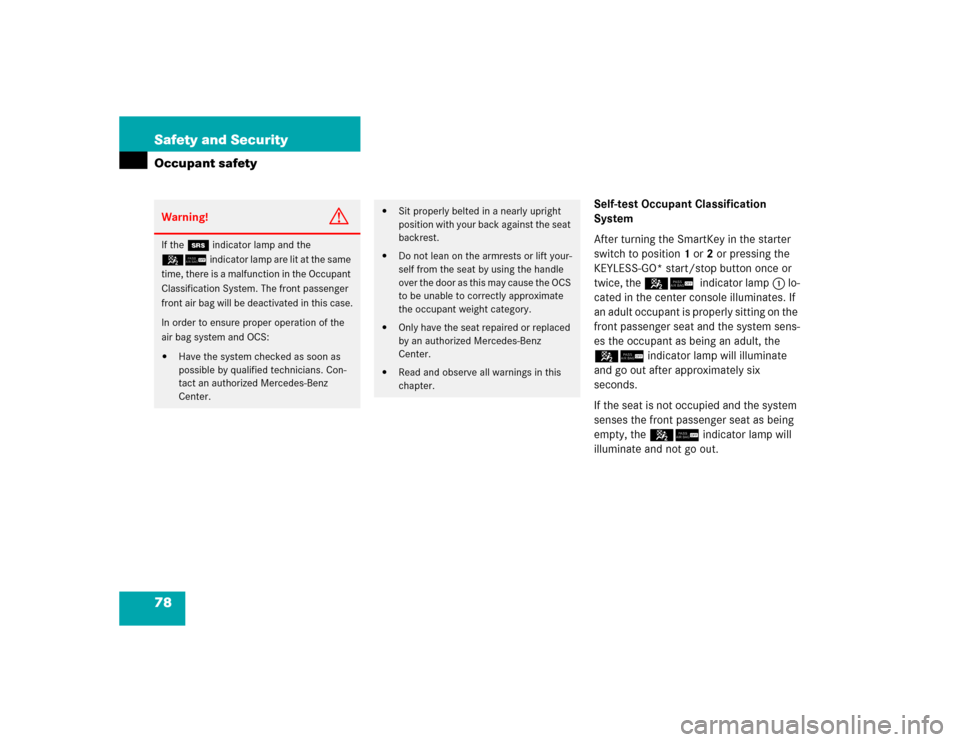
78 Safety and SecurityOccupant safety
Self-test Occupant Classification
System
After turning the SmartKey in the starter
switch to position1 or2 or pressing the
KEYLESS-GO* start/stop button once or
twice, the 56 indicator lamp1 lo-
cated in the center console illuminates. If
an adult occupant is properly sitting on the
front passenger seat and the system sens-
es the occupant as being an adult, the
56 indicator lamp will illuminate
and go out after approximately six
seconds.
If the seat is not occupied and the system
senses the front passenger seat as being
empty, the 56 indicator lamp will
illuminate and not go out.
Warning!
G
If the 1indicator lamp and the
56indicator lamp are lit at the same
time, there is a malfunction in the Occupant
Classification System. The front passenger
front air bag will be deactivated in this case.
In order to ensure proper operation of the
air bag system and OCS:�
Have the system checked as soon as
possible by qualified technicians. Con-
tact an authorized Mercedes-Benz
Center.
�
Sit properly belted in a nearly upright
position with your back against the seat
backrest.
�
Do not lean on the armrests or lift your-
self from the seat by using the handle
over the door as this may cause the OCS
to be unable to correctly approximate
the occupant weight category.
�
Only have the seat repaired or replaced
by an authorized Mercedes-Benz
Center.
�
Read and observe all warnings in this
chapter.
Page 81 of 498
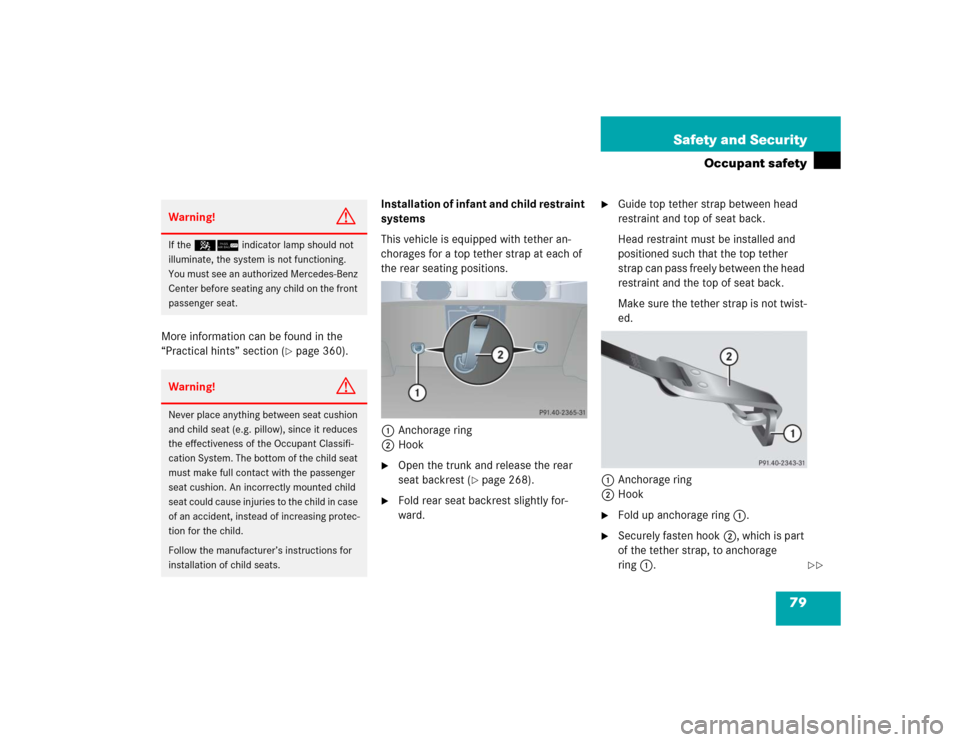
79 Safety and Security
Occupant safety
More information can be found in the
“Practical hints” section (
�page 360).Installation of infant and child restraint
systems
This vehicle is equipped with tether an-
chorages for a top tether strap at each of
the rear seating positions.
1Anchorage ring
2Hook
�
Open the trunk and release the rear
seat backrest (
�page 268).
�
Fold rear seat backrest slightly for-
ward.
�
Guide top tether strap between head
restraint and top of seat back.
Head restraint must be installed and
positioned such that the top tether
strap can pass freely between the head
restraint and the top of seat back.
Make sure the tether strap is not twist-
ed.
1Anchorage ring
2Hook
�
Fold up anchorage ring1.
�
Securely fasten hook2, which is part
of the tether strap, to anchorage
ring1.
Warning!
G
If the 56 indicator lamp should not
illuminate, the system is not functioning.
You must see an authorized Mercedes-Benz
Center before seating any child on the front
passenger seat.Warning!
G
Never place anything between seat cushion
and child seat (e.g. pillow), since it reduces
the effectiveness of the Occupant Classifi-
cation System. The bottom of the child seat
must make full contact with the passenger
seat cushion. An incorrectly mounted child
seat could cause injuries to the child in case
of an accident, instead of increasing protec-
tion for the child.
Follow the manufacturer’s instructions for
installation of child seats.
��
Page 82 of 498
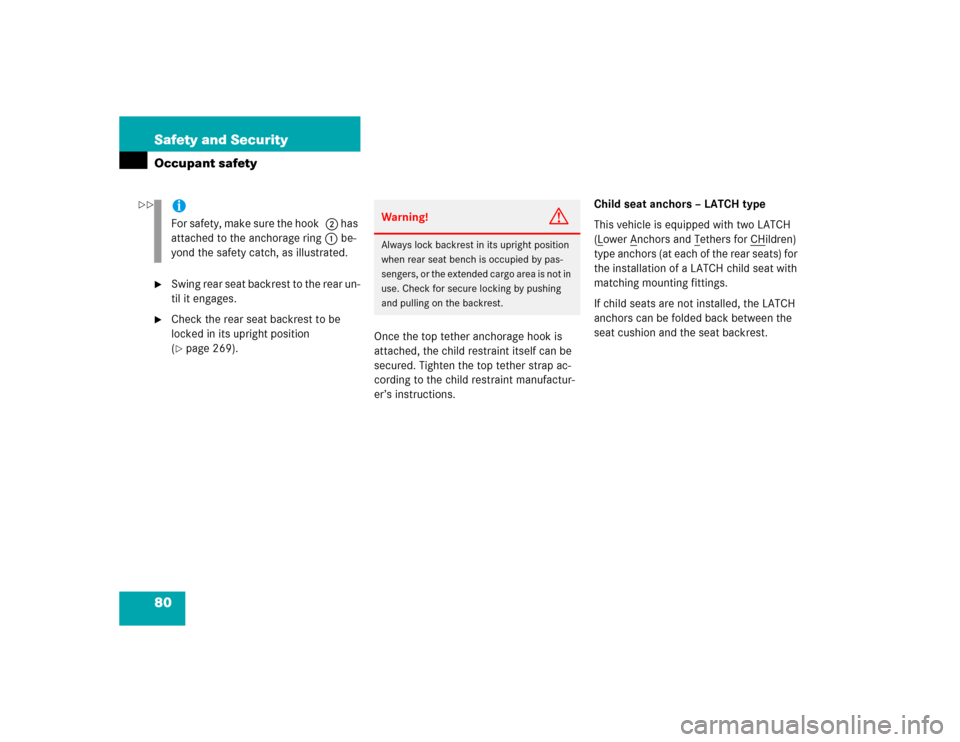
80 Safety and SecurityOccupant safety�
Swing rear seat backrest to the rear un-
til it engages.
�
Check the rear seat backrest to be
locked in its upright position
(�page 269).Once the top tether anchorage hook is
attached, the child restraint itself can be
secured. Tighten the top tether strap ac-
cording to the child restraint manufactur-
er’s instructions. Child seat anchors – LATCH type
This vehicle is equipped with two LATCH
(L
ower A
nchors and T
ethers for CH
ildren)
type anchors (at each of the rear seats) for
the installation of a LATCH child seat with
matching mounting fittings.
If child seats are not installed, the LATCH
anchors can be folded back between the
seat cushion and the seat backrest.
iFor safety, make sure the hook2 has
attached to the anchorage ring1 be-
yond the safety catch, as illustrated.
Warning!
G
Always lock backrest in its upright position
when rear seat bench is occupied by pas-
sengers, or the extended cargo area is not in
use. Check for secure locking by pushing
and pulling on the backrest.
��
Page 83 of 498

81 Safety and Security
Occupant safety
To fold anchors out
1Anchors
2Release button�
Grip inner side of anchors1 and fold
forward until they audibly lock in place.
�
Install child seat according to the man-
ufacturer’s instructions.To fold anchors back
�
Press down button2 on each
anchor1 and return the anchor1 to
its catch.
iThe child seat must be firmly attached
in the right and left side anchors1.
iNon-LATCH type child seats may also
be used and can be installed using the
vehicle’s seat belt system. Install child
seat according to the manufacturer’s
instructions.Warning!
G
Children too big for a toddler restraint must
ride in seats using regular seat belts.
Position shoulder belt across chest and
shoulder, not face or neck.
A booster seat may be necessary to achieve
proper belt positioning for children from
41 lbs until they reach a height where a
lap/shoulder belt fits properly without a
booster.
Before installing the child seat, make sure
anchors1 are folded out and locked in
place.
Install child seat according to manufactur-
er’s instructions.
T h e c h i l d s e a t m u s t b e f i r m l y a t t a c h e d i n t h e
right and left side anchor1.
An incorrectly mounted child seat may come
loose during an accident which could result
in serious injury or death to the child.
Damaged or impact damaged child seats or
child seat anchor fittings must be replaced.
Do not leave children unattended in the ve-
hicle, even if the children are secured in a
child restraint system.
Page 84 of 498

82 Safety and SecurityOccupant safetyBlocking of rear side window operation
You can block the rear door window oper-
ation (for instance when you have children
riding in the rear passenger compartment).
The override switch is located on the door
control panel of the driver’s door.
1Deactivating override switch
2Activating override switch
3Override switchActivating override switch
�
Slide override switch3 to the right in
direction2.
The rear side windows can no longer be
operated using the respective switch
located in the rear trim panels.
Deactivating override switch
�
Slide override switch3 to the left in
direction1.
The rear side windows can be operated
using the respective switch located in
the rear trim panels.
For more information, see “Power win-
dows” (
�page 247).
Warning!
G
Activate the override switch when children
are riding in the back seats of the vehicle.
The children may otherwise injure them-
selves, e.g. by becoming trapped in the win-
dow opening.
When leaving the vehicle, always remove the
SmartKey or SmartKey with KEYLESS-GO*
from the starter switch, take it with you, and
lock the vehicle. Do not leave children unat-
tended in the vehicle, or with access to an
unlocked vehicle. Unsupervised use of vehi-
cle equipment can cause an accident
and/or serious personal injury.
iOperation of the rear side windows
with the switches located on the door
control panel of the driver’s door is still
possible.
Page 85 of 498
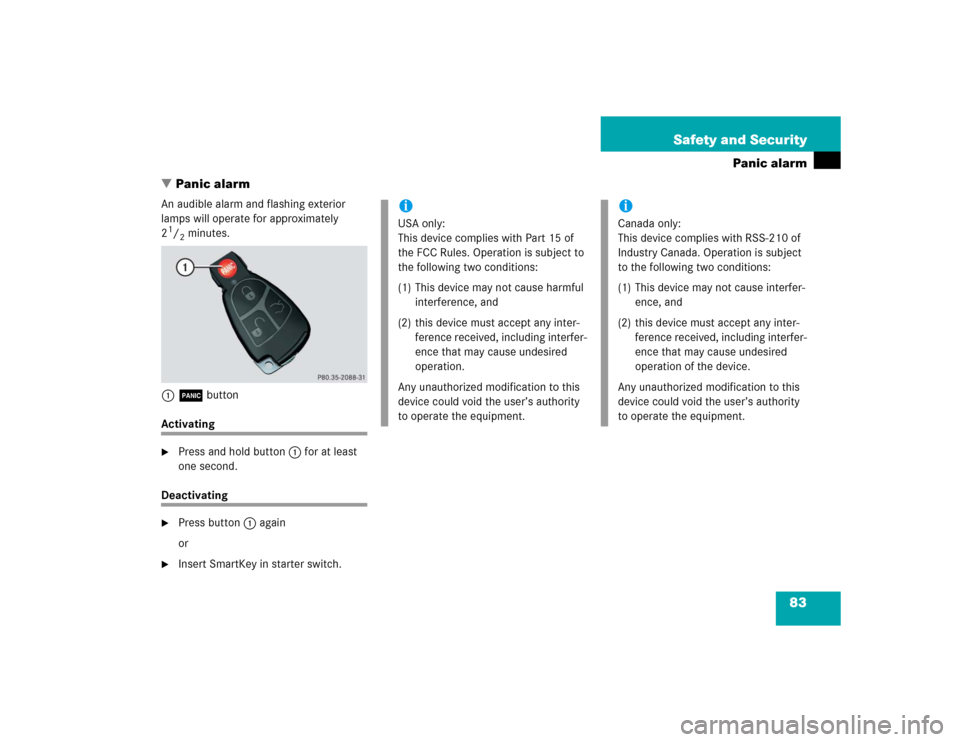
83 Safety and Security
Panic alarm
�Panic alarm
An audible alarm and flashing exterior
lamps will operate for approximately
21/2minutes.
1Â button
Activating�
Press and hold button1 for at least
one second.
Deactivating�
Press button1 again
or
�
Insert SmartKey in starter switch.
iUSA only:
This device complies with Part 15 of
the FCC Rules. Operation is subject to
the following two conditions:
(1) This device may not cause harmful
interference, and
(2) this device must accept any inter-
ference received, including interfer-
ence that may cause undesired
operation.
Any unauthorized modification to this
device could void the user’s authority
to operate the equipment.
iCanada only:
This device complies with RSS-210 of
Industry Canada. Operation is subject
to the following two conditions:
(1) This device may not cause interfer-
ence, and
(2) this device must accept any inter-
ference received, including interfer-
ence that may cause undesired
operation of the device.
Any unauthorized modification to this
device could void the user’s authority
to operate the equipment.
Page 86 of 498

84 Safety and SecurityDriving safety systemsIn this section you will find information on
the following driving safety systems:�
ABS (A
ntilock B
rake S
ystem)
�
BAS (B
rake A
ssist S
ystem)
�
ESP (E
lectronic S
tability P
rogram)
ABS
The A
ntilock B
rake S
ystem (ABS) regulates
the brake pressure so that the wheels do
not lock during braking. This allows you to
maintain the ability to steer your vehicle.
The ABS is functional above a speed of ap-
proximately 5 mph (8 km/h) independent
of road surface conditions.
On slippery road surfaces, the ABS will
respond even to light brake pressure.
The - indicator lamp in the instrument
cluster (
�page 24) comes on when you
switch on ignition. It goes out when the
engine is running.
iIn winter operation, the maximum ef-
fectiveness of the ABS, the BAS, and
the ESP is only achieved with winter
tires (M + S tires) or snow chains as
required.
Warning!
G
The following factors increase the risk of
accidents:�
Excessive speed, especially in turns
�
Wet and slippery road surfaces
�
Following another vehicle too closely
The ABS, BAS, and ESP cannot reduce this
risk.
Always adjust your driving style to the
prevailing road and weather conditions.
Warning!
G
Do not pump the brake pedal. Use firm,
steady brake pedal pressure instead. Pump-
ing the brake pedal defeats the purpose of
the ABS and significantly reduces braking
effectiveness.